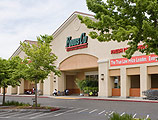Years ago—beset by the Great Recession—one of Tennessee’s finest developers shook his head at his financial statement and drawled, “My net worth’s gone down by half, but my cash flow’s the same.” He wasn’t alone. Commercial real estate nationwide lost around forty percent of its value during those trying times. His rueful comment acknowledged two things: his portfolio’s plunge in value, but more importantly, the fact that it really didn’t matter. While worth half as much, his properties were still occupied by rent-paying tenants. Because this savvy investor had lived through several recessions—they’re like high school reunions, they sneak up on you—he’d been downright abstemious with the mortgages he’d placed on his real estate. With little existing debt, he wasn’t forced to fire-sale his properties when their loans came due; he could refinance instead. Thus, his only losses were on paper—the shrunken numbers on his financial statement—and he still collected his rent. And
when the market rebounded in a couple years, his financial statement recovered.
Fast forward to today.
Real estate values may not have dropped much yet, but they’re staring down the bunny slope. We looked at our retail holdings in January, thinking we’d do a little pruning. We considered selling a Walmart supermarket in the Central Valley, and asked one of our favorite brokers what it would fetch. Because its Walmart lease is short-term, he said the property would sell at a 6 percent capitalization rate; that is, a buyer would want to earn 6 percent a year on her purchase price. Hence, if the rent were $200,000 a year (it isn’t), the purchase price would have been $3.33 million ($200,000/.06 = $3.33 million). We weren’t ready to sell in January, but we were last week. We checked back with our broker. Somewhat sheepishly, he explained that the nightmares of the last six months—the bear market, the soaring inflation and interest rates—would have buyers insisting upon an 8 percent return today. This means that our Walmart would now sell for $2.5 million ($200,000/.08 = $2.5 million). In other
words, this property has arguably declined 25 percent in value in the last six months. Like that canny Tennessean, we decided we’d rather keep our losses on paper and elected not to sell.
This example demonstrates the close resemblance single-tenant retail properties bear to the bond market: The price of both declines when their returns rise and, conversely, increases when their returns fall. And, to oversimplify things a bit, the value swings of each are irrelevant if you don’t sell: If you buy a $1000 treasury bond paying 5 percent interest and keep it to maturity, you’ll get your 5 percent every year and all of your principal back. But sell when interest rates climb to 10 percent, and your principal pancakes. On the other hand, sell when interest rates slide to 2.5 percent and your principal spikes upward. The same math works for single-tenant retail: if you don’t sell, your “cash flow’s the same.” If you do, you ride the market like a mechanical bull.
My example also implies a different point: Even if we concede a breathtaking fall in real estate values—it’s possible—we’re unlikely to see the emergence of a vibrant buyer’s market. Instead, sellers with the financial wherewithal will put their wares back on the shelves and await a sunnier day before selling. Rather than a buyer’s market, we’re likely to see buyers and sellers dug in a mile apart, entrenched in their own expectations, while we watch the market’s velocity evaporate like spit on a griddle. The sellers forced out of their redoubts by death, divorce, dissolution, disaster or simply over-leverage may indeed be slaughtered, but there’s so much money chasing real estate these days that even they may live to fight another day.
Back to that shrewd Tennessean. He understood that net worth is for bragging, cash flow is for eating. So might you.






















